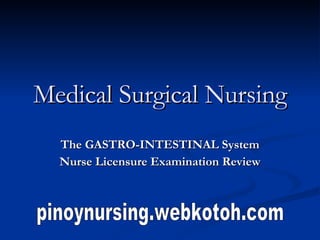Gastrointestinal System
•
37 gefällt mir•2,942 views
pinoynursing.webkotoh.com
Melden
Teilen
Melden
Teilen

Weitere ähnliche Inhalte
Was ist angesagt?
Was ist angesagt? (20)
Preoperative management of hyperthyroidism in a goiterous patient

Preoperative management of hyperthyroidism in a goiterous patient
Ähnlich wie Gastrointestinal System
Ähnlich wie Gastrointestinal System (20)
AHN-UNIT 1 PART I Electrolyte imbalance final.pptx

AHN-UNIT 1 PART I Electrolyte imbalance final.pptx
Mehr von pinoy nurze
Mehr von pinoy nurze (20)
Kürzlich hochgeladen
Kürzlich hochgeladen (20)
How to Effectively Monitor SD-WAN and SASE Environments with ThousandEyes

How to Effectively Monitor SD-WAN and SASE Environments with ThousandEyes
Passkey Providers and Enabling Portability: FIDO Paris Seminar.pptx

Passkey Providers and Enabling Portability: FIDO Paris Seminar.pptx
Enhancing User Experience - Exploring the Latest Features of Tallyman Axis Lo...

Enhancing User Experience - Exploring the Latest Features of Tallyman Axis Lo...
Transcript: New from BookNet Canada for 2024: Loan Stars - Tech Forum 2024

Transcript: New from BookNet Canada for 2024: Loan Stars - Tech Forum 2024
So einfach geht modernes Roaming fuer Notes und Nomad.pdf

So einfach geht modernes Roaming fuer Notes und Nomad.pdf
The Ultimate Guide to Choosing WordPress Pros and Cons

The Ultimate Guide to Choosing WordPress Pros and Cons
Decarbonising Buildings: Making a net-zero built environment a reality

Decarbonising Buildings: Making a net-zero built environment a reality
Generative AI for Technical Writer or Information Developers

Generative AI for Technical Writer or Information Developers
Assure Ecommerce and Retail Operations Uptime with ThousandEyes

Assure Ecommerce and Retail Operations Uptime with ThousandEyes
New from BookNet Canada for 2024: Loan Stars - Tech Forum 2024

New from BookNet Canada for 2024: Loan Stars - Tech Forum 2024
Scale your database traffic with Read & Write split using MySQL Router

Scale your database traffic with Read & Write split using MySQL Router
TeamStation AI System Report LATAM IT Salaries 2024

TeamStation AI System Report LATAM IT Salaries 2024
TrustArc Webinar - How to Build Consumer Trust Through Data Privacy

TrustArc Webinar - How to Build Consumer Trust Through Data Privacy
The Future Roadmap for the Composable Data Stack - Wes McKinney - Data Counci...

The Future Roadmap for the Composable Data Stack - Wes McKinney - Data Counci...
A Journey Into the Emotions of Software Developers

A Journey Into the Emotions of Software Developers
The Role of FIDO in a Cyber Secure Netherlands: FIDO Paris Seminar.pptx

The Role of FIDO in a Cyber Secure Netherlands: FIDO Paris Seminar.pptx
Gastrointestinal System
- 1. Medical Surgical Nursing The GASTRO-INTESTINAL System Nurse Licensure Examination Review pinoynursing.webkotoh.com
- 24. Gastrointestinal Assessment Laboratory Procedures
- 73. Conditions of the GIT UPPER GI system
- 121. Ulcers (-) cancer (+) cancer Less likely bleeding and vomiting Bleeding, weight loss and vomiting RELIEVES by food WORSENS by food, RELIEVED by VOMITING Pain late after eating (2-4 hours) Pain early after eating INCREASED acidity Normal Acidity Younger Older DUODENAL GASTRIC
- 122. Conditions of the Lower Tract Small and Large Intestine
- 158. Conditions of the GIT accessory organs The liver
- 162. Liver physiology and Pathophysiology = Gynecomastia, testes atrophy 8. Metabolizes estrogen = Deficiencies of Vit and min 7. Stores Vit and minerals =Hyperammonemia 6. Converts ammonia to urea = Jaundice and pruritus 5. Secreting bile = Bleeding tendencies 4. Synthesizes Clotting factors = Decreased Antibody formation 3. Synthesizes globulins = Hypoproteinemia 2. Synthesizes proteins = Hypoglycemia 1. Stores glycogen Abnormality in function Normal Function
- 173. Conditions of the Accessory organs The Gallbladder
- 197. Conditions of the accessory organs The pancreas: Exocrine function
- 218. End Of GIT SYSTEM
